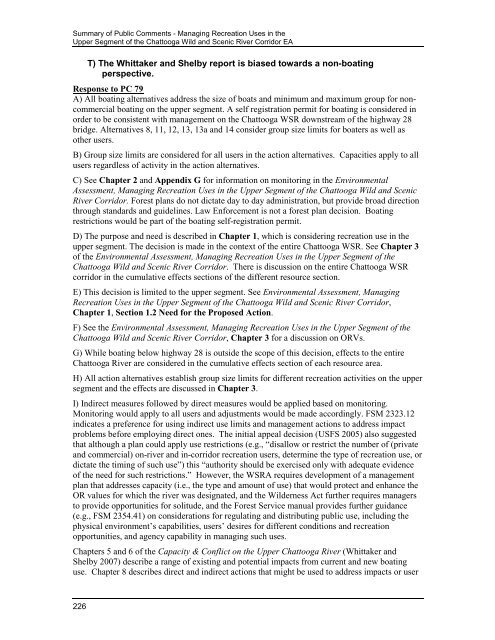Resource Name (Heading 1) - USDA Forest Service - US ...
Resource Name (Heading 1) - USDA Forest Service - US ...
Resource Name (Heading 1) - USDA Forest Service - US ...
Create successful ePaper yourself
Turn your PDF publications into a flip-book with our unique Google optimized e-Paper software.
Summary of Public Comments - Managing Recreation Uses in the<br />
Upper Segment of the Chattooga Wild and Scenic River Corridor EA<br />
T) The Whittaker and Shelby report is biased towards a non-boating<br />
perspective.<br />
Response to PC 79<br />
A) All boating alternatives address the size of boats and minimum and maximum group for noncommercial<br />
boating on the upper segment. A self registration permit for boating is considered in<br />
order to be consistent with management on the Chattooga WSR downstream of the highway 28<br />
bridge. Alternatives 8, 11, 12, 13, 13a and 14 consider group size limits for boaters as well as<br />
other users.<br />
B) Group size limits are considered for all users in the action alternatives. Capacities apply to all<br />
users regardless of activity in the action alternatives.<br />
C) See Chapter 2 and Appendix G for information on monitoring in the Environmental<br />
Assessment, Managing Recreation Uses in the Upper Segment of the Chattooga Wild and Scenic<br />
River Corridor. <strong>Forest</strong> plans do not dictate day to day administration, but provide broad direction<br />
through standards and guidelines. Law Enforcement is not a forest plan decision. Boating<br />
restrictions would be part of the boating self-registration permit.<br />
D) The purpose and need is described in Chapter 1, which is considering recreation use in the<br />
upper segment. The decision is made in the context of the entire Chattooga WSR. See Chapter 3<br />
of the Environmental Assessment, Managing Recreation Uses in the Upper Segment of the<br />
Chattooga Wild and Scenic River Corridor. There is discussion on the entire Chattooga WSR<br />
corridor in the cumulative effects sections of the different resource section.<br />
E) This decision is limited to the upper segment. See Environmental Assessment, Managing<br />
Recreation Uses in the Upper Segment of the Chattooga Wild and Scenic River Corridor,<br />
Chapter 1, Section 1.2 Need for the Proposed Action.<br />
F) See the Environmental Assessment, Managing Recreation Uses in the Upper Segment of the<br />
Chattooga Wild and Scenic River Corridor, Chapter 3 for a discussion on ORVs.<br />
G) While boating below highway 28 is outside the scope of this decision, effects to the entire<br />
Chattooga River are considered in the cumulative effects section of each resource area.<br />
H) All action alternatives establish group size limits for different recreation activities on the upper<br />
segment and the effects are discussed in Chapter 3.<br />
I) Indirect measures followed by direct measures would be applied based on monitoring.<br />
Monitoring would apply to all users and adjustments would be made accordingly. FSM 2323.12<br />
indicates a preference for using indirect use limits and management actions to address impact<br />
problems before employing direct ones. The initial appeal decision (<strong>US</strong>FS 2005) also suggested<br />
that although a plan could apply use restrictions (e.g., “disallow or restrict the number of (private<br />
and commercial) on-river and in-corridor recreation users, determine the type of recreation use, or<br />
dictate the timing of such use”) this “authority should be exercised only with adequate evidence<br />
of the need for such restrictions.” However, the WSRA requires development of a management<br />
plan that addresses capacity (i.e., the type and amount of use) that would protect and enhance the<br />
OR values for which the river was designated, and the Wilderness Act further requires managers<br />
to provide opportunities for solitude, and the <strong>Forest</strong> <strong>Service</strong> manual provides further guidance<br />
(e.g., FSM 2354.41) on considerations for regulating and distributing public use, including the<br />
physical environment’s capabilities, users’ desires for different conditions and recreation<br />
opportunities, and agency capability in managing such uses.<br />
Chapters 5 and 6 of the Capacity & Conflict on the Upper Chattooga River (Whittaker and<br />
Shelby 2007) describe a range of existing and potential impacts from current and new boating<br />
use. Chapter 8 describes direct and indirect actions that might be used to address impacts or user<br />
226
















